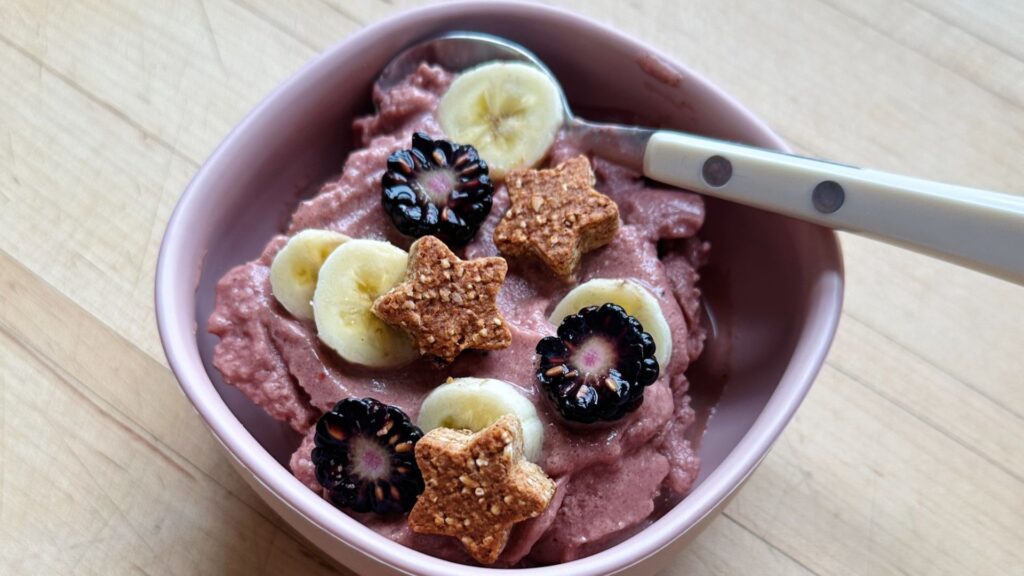Choosing Your Baby's First Foods
The transition from breastfeeding or formula feeding to eating solid foods can be very intimidating as there is no one-size-fits-all approach. My name is Devon Kuehn, I’m a mom, a neonatologist, and the Chief Medical Officer at the infant nutrition company, ByHeart, Inc. At ByHeart, we believe in well-fed, however you do it, and are dedicated to providing the resources to help make this process feel amazing—for babies’ health and parents’ peace of mind. I am so excited to share some tidbits of information to help you navigate this exciting time as you choose your baby’s first foods
I am always so inspired by how nutrition during the first months of your child’s life can impact their health for years to come. Did you know that food choices before age two can actually support brain development?
Not all foods provide the same nutritional quality, so making the most of baby’s mealtime choices is key. At ByHeart, we believe that each ingredient in our formula should provide the highest nutritional value possible, which is why we were very intentional in our choice of proteins and are the first US-made formula to include whole milk instead of skim milk.
During the early months, breast milk and formula will continue to provide the majority of their nutrition, so when selecting specific complementary foods, the focus should also be on variety and quality, not the quantity. Many parents start with pureed foods, and this can be a great way to introduce a wide variety of nutrients. Purees do not have to just mean carrots and apples! If you choose to purchase pureed foods, look for nutrient dense options like Cerebelly.

Iron and zinc are two key nutrients that I encourage parents to think about during this time. Both are essential for brain development. Not getting enough iron can result in long-term learning and social-emotional consequences, and not enough zinc can result in poor growth and brain development.
While babies are born with enough iron and zinc stored to meet their needs early on, these stores typically run out between four and six months of age and at that point, they need to be provided from food. This is especially true for babies who are solely breastfed (breast milk has less iron than iron-fortified infant formula).
So, what can you do to help your little one get the right amount of iron and zinc from their diet? The answer is to regularly choose high-quality, age-appropriate foods with these nutrients, like meat, poultry, seafood, eggs, beans, nuts, and iron-fortified cereals. Here are some ideas to help you introduce these foods to your little one:
- Many parents choose rice cereal or oatmeal as baby’s first solid food – check the label to ensure your choice is iron-fortified.
- Include green peas in the rotation of early pureed or mashed foods.
- Well-cooked scrambled eggs make a great soft food option.
- Don’t forget that beans, meat, and fish can be diced, pureed, or served mashed.
- Add ground beef to noodles or casseroles (bonus if you add tomato sauce because the vitamin C in tomatoes helps iron be better absorbed).
- Tofu is not only a source of iron but also high in protein; try it diced for younger babies.
- Look for recipes for stews or soups with well-cooked soft meats. Chili with beans or lentil soup are other great choices.
- Introduce nut butters as recommended by your pediatrician.
- Use hummus as a spread or dip.
- Take purees on the go for a convenient option.
Another key nutrient to keep in mind when choosing your baby’s first foods is fat. Fat has a bad reputation but is necessary for growth and brain development during infancy. Focus on “healthy fats” such as olive oil, avocados or avocado oil, nut or seed butters, and fatty fish such as salmon. In addition, any cheese, yogurt, or kefir should be full-fat as dairy fat not only provides calories for growth but also nutrients known to support brain development.
Don’t stress if your baby isn’t gobbling up new foods immediately. Babies will often reject most, or even all, of their first servings of food – the new tastes, smells, and textures can take some time to get used to. If your baby refuses food, there is no need to force it. Stay calm, stay patient, and continue trying! A fun fact, and one to keep in mind if your baby refuses certain foods: it can take up to 8-10 exposures for an infant to accept a new food/flavor. Try offering foods in multiple forms or different preparations to change it up.

Another tip is to offer breast milk or formula first, so your baby isn’t overly hungry, which can make them more likely to get frustrated while learning this new skill. If they are still hungry, you can always finish their meal with more breast milk or formula after trying a new food. In other words, nothing about your breastfeeding or formula feeding schedule needs to change with the introduction of foods.
If refusal continues, talk to your pediatrician or a recommended registered dietitian to make sure their resistance isn’t a sign of a problem. As eating skills and interest in foods develop, many babies start to wean (gradually) on their own; it is natural to start consuming less formula or breast milk around 9-12 months.
I hope that these tips have been helpful as you get started with the transition to complementary foods. Before you know it, you will be packing lunches for kindergarten!
not ready for solids yet?
At the infant nutrition company, ByHeart, we believe in well-fed, however you do it, and are dedicated to providing the resources to help make this process feel amazing—for babies’ health and parents’ peace of mind.
Have more questions? Send us an email at support@cerebelly.com and we will be sure to get back to you!



